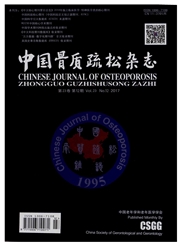

 中文摘要:
中文摘要:
目的深入研究补肾调肝方诱导衰老骨髓间充质干细胞(Bone Mesenehymal Stem Cells,BMSCs)成骨分化的效应,探讨补肾调肝方抗骨质疏松的机制。方法贴壁培养法分离纯化大鼠BMSCs,用D-半乳糖诱导制作BMSCs衰老模型,β-半乳糖苷酶染色检测BMSCs衰老情况。将培养成功的衰老BMSCs分为空白组、成骨诱导组和中药组,培养7d、14d后行矿化结节茜素红染色(AlizarinRedS,ARS),倒置显微镜下观察矿化骨结节形成情况。结果D-半乳糖诱导BMSCs呈现典型的细胞衰老形态和结构变化。在成骨诱导剂、补肾调肝方水提液的作用下,与空白组比较,衰老的BMSCs钙化结节数量明显增多,差异有非常显著的统计学意义(P〈0.01)。中药组的矿化结节明显多于成骨诱导组,差异有非常显著的统计学意义(P〈0.01)。结论D-半乳糖具有诱导SD-大鼠BMSCs衰老的作用,采用D-半乳糖诱导培养可建立BMSCs衰老模型。补肾调肝方抗骨质疏松的机制之一是通过促进衰老BMSCs成骨分化。
 英文摘要:
英文摘要:
Objective To investigate the osteogenic differentiation of aging bone mesenehymal stem cells (BMSCs) induced by kidney-tonifying and liver-regulating recipes, and to explore its anti-osteoporosis mechanism. Methods BMSCs of SD rats were isolated with adherent separation method and primarily cultured in vitro. BMSCs senescence model was induced by D-galactose, and the senescence of BMSCs was detected byβ-gal dyeing. Successfully cultured aging BMSCs were divided into 3 groups: blank group, osteo-induced group, and Chinese medicine group. After 7-day and 14-day culturing, Alizarin red staining was performed. And the formation of mineralized nodules was observed under phase-contract microscope. Results Compared with control ceils, BMSCs induced by D-galactose displayed morphological and biological senescent phenotype. Using osteogenic inducer and water extract of kidney-tonifying and liver- regulating recipes, the number of mineralized nodules was notably more than that in blank group. The difference was significant (P 〈 0. 01 ). The number of mineralized nodules in Chinese medicine group was more than that in osteo-induced group (P 〈 0. 01 ). Conclusion D-galactose can induce BMSCs senescence. BMSCs senescence model can be established by culturing with D-galactose. One possible mechanism of kidney-tonifying and liver-regulating recipes in treating osteoporosis is to promote osteogenic differentiation of aging BMSCs.
 同期刊论文项目
同期刊论文项目
 同项目期刊论文
同项目期刊论文
 期刊信息
期刊信息
